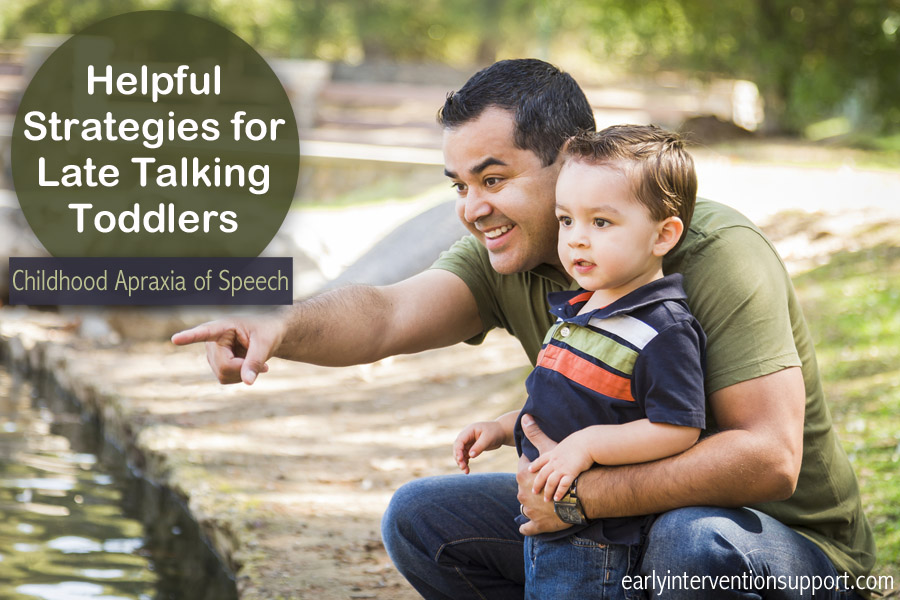In our previous article, Childhood Apraxia of Speech, we discussed some characteristics of suspected apraxia of speech in toddlers. To redefine childhood apraxia of speech (CAS), it is a motor speech disorder. A child who has CAS will have difficulty planning motor movements for speech production. So, what does this mean? A child with CAS will often know what they want to say, but when they go to say a word, the word that was in their brain gets lost before it gets to the mouth and throat to produce the word. This results in the word not coming out at all, or not coming out correctly.
Encourage Late Talking Toddlers to Speak
Again, it is very difficult to determine if a child has apraxia of speech until a child begins talking. If you have a late talking toddler or a 2 year old not talking, there are some strategies that you can begin to use to help your child learn to talk. It is important to know that every toddler will learn speech and language at his own pace. Here are a few things to consider that may help your child learn to talk:
- Eye Contact: Will your child watch your face when you are talking? Does he or she look at your eyes? Will he or she look at your mouth? It is very important that your child is watching your face when you are speaking. Hold desired objects by your face so they can see how you are saying it. Do silly things like placing stickers on your nose to draw attention to your face. Say what is on the sticker.
- Encourage Imitation: Is your child imitating things you are doing when you play with him or her? For example, will he feed the puppy with a bottle after you do it? Will she brush the baby’s hair after you do it? Is your child imitating movements you do, like clapping hands, stomping feet, turning around? Imitation is a very important skill for learning to talk. BEFORE a child begins imitating words, they must be good physical imitators. If your child is not using any words, or very few, encourage them to imitate things YOU DO, not SAY. If your child isn’t imitating words, the expectation to get them to say words is too high, so we need to begin with something easier—imitating actions. There is nothing wrong with modeling words for your child all the time, but as far as expectations, only expect them to imitate actions, especially if verbalizing is hard for them. Here are some examples of things you can do to encourage imitation: stacking up blocks and knocking them down, feeding a baby doll or stuffed animal, blowing on food that is hot, banging toys together, placing objects on your head and “sneezing” them off. Try some songs that involve finger plays like “The Itsy Bitsy Spider”, “Head Shoulders Knees and Toes” or “Teddy Bear, Teddy Bear”. Another important idea to try with your child is to imitate things that he/she is doing during play or moving around your home. When you imitate your own children, they often find this a lot of fun and this can encourage them to imitate you!
- Think “Sounds” not “Words”: If your child is a very quiet child, another thing you want to encourage him or her to do is to begin to use the voice and articulators (the muscles of the mouth) more often. Begin to emphasize sounds, like vehicle sounds (vroom, beep beep, whoo whoo), animal sounds, other environmental sounds like the phone ringing or the vacuum running, “plop” for throwing a stone in water, “Shhh” when putting baby to bed or putting gas in the car, “Ahh” after taking a drink of water. Attempting to imitate sounds like these is much easier than trying to say long words.
- Use a lot of repetition: Say sounds and words over and over and over again. When going up and down the stairs, say “up, up, up”, “down, down, down”. When playing with cars, “go go go”. If playing with a hammer or wooden spoon, “boom, boom, boom”.
There are many other strategies that can help your child, and these are just a start. Always remember to seek advice from your speech-language pathologist to help direct you more specifically with your child’s speech and language goals. Even if it seems like some of the things you are trying are not helping, be consistent! Toddlers love routine and predictability. When a child is learning to talk, it sometimes seems like you are doing more of the talking, but that’s ok. It is so important that they hear you talking and your voice. Teaching your child to talk takes a lot of time and patience (from our end), and for our late talkers, they need praise and encouragement for the small steps and lots of time to keep learning sounds and words!
References:
Ebert, Cari (2011). Suspected Apraxia in Early Intervention presentation December 16, 2011. Pittsburgh, PA.

